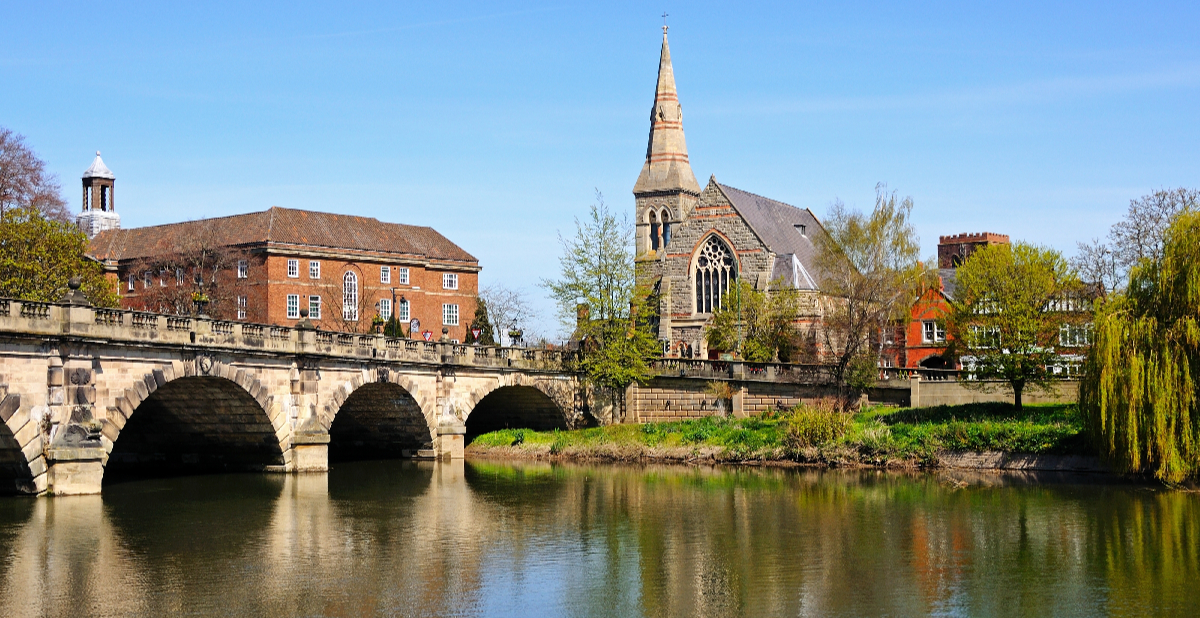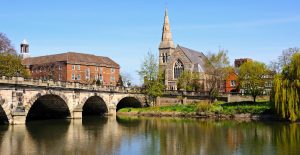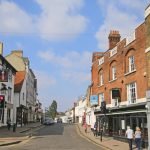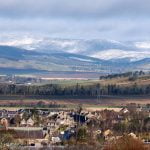
Everything you ever needed to know about Shrewsbury, and more!
Shrewsbury is a healthy-sized town that sits on the edges of the River Severn. It contains everything from picturesque sandstone castles, right through to the occasional swan on the idyllic waterways. It’s a large town with a small-town feel… and that’s something most British towns are jealous of.

Image: Caron Badkin/Shutterstock.com
Join us as we talk about all things Shrewsbury for a little while. Is it your hometown or are you just passing through? It doesn’t matter, really, because either way this picturesque place is packed with the history of the ages. Let’s start with the early days and work forward from there.
Shrewsbury in the Early Days
Shrewsbury history extends all the way back to the time before the Romans invaded Britain… that’s pre-AD years. Some sources have it as being officially founded in 901 as a burgh town, which meant that it would have had a fortification. The building was probably earthen and in roughly the same place as the castle is, now.
Shrewsbury saw early success, rising to fame as the capital city of the Kingdom of Powys. It is thought that the etymology behind the name comes from the early name of Scrobbesburh, which would have meant something like ‘the fort that belonged to Scrobbe’ back in the Old English tongue.
In the Roman era (circa 40 AD onwards), Shrewsbury wasn’t the star of the show that it was in the early days. In fact, there is a village about 5 miles to the south and east named Wroxeter, where the Romans established one of their largest forts. It was considered to be the 4th biggest capital of Britain back in their day… and Shrewsbury would have been nothing but a small village growing up around the Roman road.
Cut forward from the pre-Roman years to 778 and the capital of Powys fell into the hands of the invading Offa of Mercia… who definitely Was Not a Viking King. Officially speaking, Shrewsbury was ‘founded’ in 800 BC, but that’s only because we are more confident in the history from that point forward.
Shrewsbury was so big by 900 AD that it had its own mint, a building only established in highly profitable trading towns. There would have been a weekly market and annual trade fair, which would have allowed people to come and buy or sell from all over Shropshire. It had also managed to retain the earthworks and fortifications that made it a burgh to begin with.
The Doomsday Book
By the time of the Domesday Survey, a record of all the lands in England compiled by William the Conqueror after he won in 1066, Shrewsbury had its own Earl and about 86 households. There were 10 landowners in possession of parts of the town, which is almost a Domesday record. It makes Shrewsbury one of the largest 20% of towns in England at that time.
In those days, Earl Roger of Shrewsbury earned a whopping 40 pounds a year from the lands. There was evidently an important church in town because some of the lands belonged to the Bishop of Chester. St. Peter’s Abbey was a staple in the area too, owning some land of their own.
All in all, Shrewsbury was quite a busy place in the middle ages. There is a record of it being held by rebels until 1069 and then set alight, rather than being turned over during the Norman invasion. Since most of the town would have been wooden at the time, this comes as little surprise.
In 1083, Roger de Montgomery built the castle in place of the earthen fortifications In the 12th century, Shrewsbury received two charters, one from King Henry I and one from King Richard of Robin Hood notoriety. When the 13th century rolled around, it was a thriving market town that nestled behind its own walls. It would have had about 3000 people living within the walls, which was a huge number for those times. The modern-day equivalent would be a city with 300,000 people in it – and trade would have been flourishing.
Medieval Shrewsbury
The Middle Ages saw Leatherworking as one of the main trades in town. With so much farmland in surrounding Shropshire – which is now used for sheep, leather and cattle would have been bred in abundance. Skinners, glove makers, drapers, tailors, and even those involved in weaving wool, were all trades known to the town.
In 1215 the town was briefly captured by the Welsh, who seemingly always had battled with the inhabitants throughout history. Llewlyn the Great was therefore in charge of Shrewsbury for a few short months. This whole period came to a head in 1403 when the battle of Shrewsbury was fought. Lord Harry Percy led a rebellion against the king and the resulting fights took place in the streets of the town. Harry Hotspur was killed in the rebellion and casualties ran into the thousands.
Franciscan friars showed up in the 13th century and remained there until the 15th century. During the latter time period, Henry VIII was taking down abbeys and friaries all over England. The success of the religious organisations in town would have waned during this time.
By the time the 16th century started, Shrewsbury was making most of its money in wool. It was fulled and dyed in town, where it would then be traded up and down the river. The abbey and all other religious establishments in town were closed finally in 1540, and by 1658 the town’s population had double to the 6 thousand mark.
That’s a good natural pausing place to take a break. Let’s look at something a bit more light-hearted before we continue with the gloom of history.
Fun Shrewsbury Trivia
Just in case you need to impress any people at parties (remember when we could still go to parties?), here are the Five Minutes Spare favourite fun facts about Shrewsbury. Some might be morbid, and not very fun at all, but we can promise that they will be interesting, at least.
- Charles Darwin was born and studied here before he went on to write about the Origins of our Species.
- There are 32 castles and 24 hillforts between Shrewsbury and the surrounding Shropshire countryside.
- Both Ironbridge Gorge and Pontcysyllte Aqueduct on either side of the town are World Heritage Sites with UNESCO.
- Muller yoghurts have their home in Shrewsbury, not Germany, as many people suspect. It is from their Shrewsbury factory that most of their UK products are made – and 90% of the milk they use come from farms within a 30-mile radius.
- The Shropshire hills, which are visible from all over the city, are a designated Area of Outstanding National Beauty, which is a bit of a big deal in England and gives them protection from destruction.
And there you have it… a handful of facts you can whip out at parties to make you sound as fully informed as your average Shrewsbury native. Good luck! You’ll have to wing it the rest of the way.
The Industrial Era
The 16th century saw loads of improvements going on in town. The Drapers Hall was built in 1658, with a school added in 1552. The Ireland Mansion was a 1575 addition, with the Market Hall going up to provide indoor shopping space in 1592. In 1618 Rowley’s House was built, and by the 18th century, they had rebuilt both of the bridges that crossed the river.
Let’s not pass by the English Civil War of the 16th century, which led to the town becoming a Royalist stronghold. It was captured by the Parliamentarians in 1645 – but it wasn’t done with the horror of war just yet. a dozen Irish prisoners were executed after drawing short straws, to be made an example of. Over the years, the streets of Shrewsbury have seen some real violence.
Coaches regularly ran through town for those travelling to Ireland and even on to America. In 1743, the town got its first hospital, which was followed by a bit of a disaster in 1788, when a local church collapsed. They were attempting to expand the crypt and instead caved it all in. It took only four years to rebuild.
In 1762, Clive of India was the town Mayor – no joke – and at the end of the century, the castle was brought up-to-date to become a home. It was a Shrewsbury regiment that went to the Isle of St. Helena to guard Napoleon after his defeat at Waterloo. To this day, a stolen lock of his hair remains in the castle.
The world’s first Iron-Framed Building was erected in Industrial Shrewsbury. The Ditherington Flax Mill was built to process the flax made popular after the American cotton shortage during the Civil War there. To this day, the mill remains a Grade I listed building of national importance. It is estimated that there are more than 600 listed buildings in Shrewsbury.
Population Boom
In the early 19th century, Shrewsbury had a population of about 15k. 50 years later it was more like 20k, with it rising to the 71k we know today over the next two hundred years. This started with the introduction of the canal in the 19th century, which would have been used to join the town to the rest of the world.
In the mid-19th century, Shrewsbury had more people than it had either homes or sewerage systems. A town council was set up to take care of these issues, as well as to light the town and keep it swept. Nevertheless, there were several cholera outbreaks here over the next hundred years or so.
The railway was added about the same time, with a second railway connecting them to Wolverhampton in 1850. In 1840 a music hall was built, and a market was added in 1869. Next, the town saw another two bridges added, and new suburbs springing up as the need for fabrics woven here drove expansion.
Shrewsbury in Modern Times
The modern era has seen vast growth in the town. WWI would have seen thousands of young men from the town sign up to the buddy regiment system. This system meant that, whole towns of young men were wiped out in the trenches and formed the foundation for which young people who join the British Army nowadays to be sent to regiments far from their hometown.
By the time the world war hit, there were actual slums in the town. Without indoor plumbing and with such huge leaps in numbers of residents, there were literal ghettos in the streets. Between the two world wars, the council worked hard to reposition many of those who still lived in slum areas.
During WWII there were few bombs dropped on Shrewsbury. A cottage was destroyed in 1940, which contained a grandmother and two children, but besides this the town got off relatively lightly given its size. Redevelopments of the council house areas of town managed to wipe out any evidence of this bombing in the 60s and 70s, though.
Post War Shrewsbury
In 1951, the council added yet another bridge. They put a new market hall building in circa 1963, and the trades of the town switched to engineering and malting, as well as tourism, by the start of the 20th century. Several museums were opened, and a regional shopping centre was added, all of which drove warmth and wealth to the centre of town.
The IRA took it upon themselves to bomb Shrewsbury in the 90s. One bomb went off in the castle and cause about a quarter of a million pounds worth of damage to some fairly priceless artefacts. Another bomb went off in the Darwin shopping centre but did little damage. A third bomb was located and diffused before it did any harm. Still, this recent attack is a reminder that we need to be vigilant from terrorism, even right here in middle England.
Recent years has seen the residents of Shrewsbury left frustrated as the River Severn floods almost every year. It was awarded the title of ‘Capital of Enterprise in 2004 and does do well in the engineering area. Since then, all seems to be quite on the Shrewsbury front… except from in ’05, when reports claimed that the prison there was one of the most crowded in England… we suppose you have to be famous for something.
Shrewsbury is a nice place that grows nicer every year. This is due to the local council having one eye on tourism at all times. Let’s round up the history by saying we hope this town can regain its former status as a capital one day and move on to the famous faces…
Famous People born in Shrewsbury
Shrewsbury has played host to some exceptionally famous faces in the past, some of which extend beyond local fame into world renown… like Charles Darwin – who we are not going to mention again, we promise… well, maybe in the museum section…
Anyway, here are the Five Minutes Spare favourite famous faces from Shrewsbury, for your enjoyment:
- Journalist Suzanne Evans is from here.
- The Author of crime novels Malcolm Pryce comes from Shrewsbury.
- Youtuber NoughtPointFourLive lives in Shrewsbury.
- TikTok star Louis Wright is also a Shrewsbury man…
So we can safely say that they are being dragged into the new century in terms of famous faces.
Things to see and do in Shrewsbury
Now we have reached the part everyone has been waiting for – the things to see and do in Shrewsbury should you be there on holiday. Here are some of Five Minutes Spare favourite things to do in town.
Historical Attractions and Landmarks
Shrewsbury Prison is one of the best historical landmarks in town. You can go for the full experience since it is part museum and part lock-in. This is where you take the teens if they start acting up…
The Market Hall is still in use today and sports numerous stalls and small businesses. Go along and show your support inside the historic 18th-century building.
St. Chad’s Church, that’s the one that was rebuilt after they broke it extending the crypts, is a dazzling sight to see. If you are looking for landmarks for IG photos, check out this place along with St. Mary’s Church. Don’t forget the Abbey is still standing and operational, too, and so is the Shrewsbury Cathedral.
Outdoor Attractions
The old quarry was turned into a fabulous garden and public park in the Victorian era. To this day, it makes for a beautiful place to visit and have a stroll. Second, to its beauty, you can find Attingham Park as a firm favourite place to sunbathe or have a family picnic.
If you want something a little different on the outside, check out the ruins of the old Haughmond Abbey that was shut down by Henry VIII. This place has some ominous vibes to it, and parts of it might cave in on you so do be careful.
Galleries and Museums
Shrewsbury Museum and Art Gallery will give you a holiday dose of both fine art and Shrewsbury history. With some fairly successful history behind it, there are bound to be interesting artefacts to explore there. However, it isn’t the only museum in town.
The Shropshire Regimental Museum has been in Shrewsbury for years now. It houses the regimental records, which allow you to trace the names of any of your ancestors that were in the regiment… pretty cool.
Sports and Recreation
There are several options for the holidaying golfer. Check into the Shrewsbury driving range, the Meole Brace Golf Course, or take a turn on Shrewsbury Golf Course.
Shrewsbury Town FC is the local club but they don’t have that Premiership status of other town clubs. You can still take a tour of their stadium if you are in town.
Shopping and Retail
The Darwin Shopping Centre, named for the man himself, is still the main shopping hub in town. You will also find good stores in the town centre, and you can visit the Parade Shops for even more choice. The best-rated stores are said to be found in the centre of town.
Other Shrewsbury Attractions
There is so much to see and do in Shrewsbury that we haven’t even managed to scratch the surface yet. We have assembled some of the Five Minutes Spare best bits of Shrewsbury below, for you to choose from:
- The Battlefield Falconry Centre has both falcons and owls, it’s a great day out.
- Climbing the Walls is one of the best activity centres in town if you want to entertain unruly children for a few hours.
- The Hawkestone Park Follies make for a nice hike in good weather.
- Haughmond Hill is another brilliant outdoor climb for you.
And there are dozens of other places… the Shropshire Falconry Ltd centre, Stiperstones Nature Reserve in Shrewsbury, the Theatre Severn, the Wroxeter Roman Vineyard… the list is endless.
How to Get There?
We couldn’t leave you hanging without telling you how to actually get to Shrewsbury in the first place. Let’s talk directions… How the hell do you get to Shrewsbury, anyway?
By Road
Shrewsbury is on the A5 heading north and west out of Wolverhampton.
By Rail
Shrewsbury Railway Station is your best bet. It is on the northern line. Be wary that there is a Shrewsbury in Wales, too.
By Air
Liverpool airport is the nearest, being about 43 miles away. Leave a good hour before you need to be at the airport.
By Sea
Shrewsbury is landlocked but you could reach it on a boat by sailing the river Severn… ask the Vikings.
Got Five Minutes to Spare?
If you are still craving something to read – whether through lockdown boredom or through general interest – head on over to the Five Minutes Spare home pages. Don’t forget that you can even give us a follow on Facebook if you like what you see. You never know, we might even have covered your hometown.




